Norwegian Air Shuttle Bundle
Can Norwegian Air Shuttle Soar Again?
Norwegian Air Shuttle, a key player in the Norwegian Air Shuttle SWOT Analysis, has navigated the turbulent skies of the airline industry for decades. Founded in 1993, the company's journey has been marked by ambitious expansions and strategic pivots. Understanding its growth strategy and future prospects is crucial for anyone tracking the airline industry.
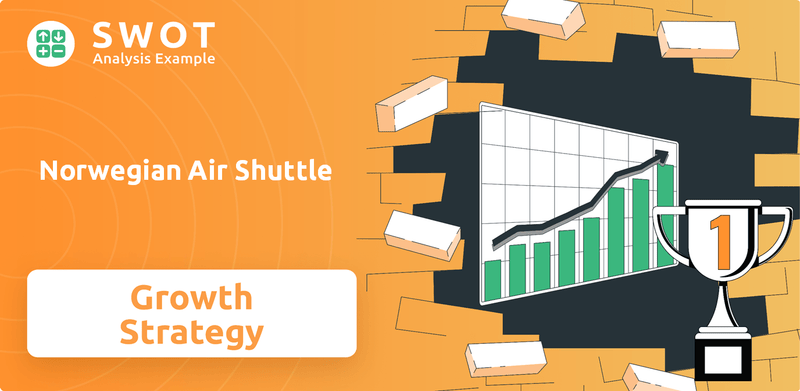
This analysis will dissect Norwegian Air Shuttle's current position, examining its expansion plans, and assessing its financial outlook. We'll explore the market analysis to understand the challenges and opportunities. The article will provide actionable insights into its Norwegian Air Shuttle business model and the impact of various factors, including fuel prices on Norwegian Air Shuttle and its competitive landscape.
How Is Norwegian Air Shuttle Expanding Its Reach?
The Brief History of Norwegian Air Shuttle highlights the company's evolution and its strategic shifts. Its growth strategy is currently centered on strengthening its position in the European short-haul market. This involves expanding its route network, particularly to leisure destinations, to capitalize on the post-pandemic travel recovery and meet the growing demand.
Norwegian Air Shuttle's future prospects are closely tied to its ability to adapt to market dynamics and manage risks effectively. This includes a cautious re-entry into the long-haul market through strategic partnerships and wet-lease agreements. The company is also focusing on enhancing its product offerings and forming strategic alliances to broaden its reach without significant capital expenditure.
The airline's expansion plans are designed to ensure profitable growth. This is achieved by carefully adjusting its network and fleet in response to market demand. Recent reports suggest a strong summer 2024 program and plans for further network adjustments based on profitability, indicating a proactive approach to market changes.
Norwegian is actively expanding its route network within Europe. This expansion focuses on leisure destinations to capitalize on the rebound in travel. New routes and increased frequencies for the summer 2024 season demonstrate this commitment.
The airline is cautiously re-establishing long-haul operations. This is primarily done through partnerships and wet-lease agreements. This approach helps manage risk and test markets before making significant investments.
Norwegian is exploring ways to improve its product offerings. This includes potential premium services on select routes. The goal is to attract a broader range of travelers and increase revenue.
The company is considering partnerships with other airlines. These partnerships aim to expand connectivity and reach. This strategy helps avoid large capital expenditures while growing the network.
Norwegian Air Shuttle's growth strategy involves a multi-faceted approach. This includes route network expansion, strategic partnerships, and enhanced product offerings. The focus is on profitable growth and adapting to market demands.
- Expanding the route network to meet growing demand.
- Re-entering long-haul markets through partnerships.
- Enhancing product offerings to attract more customers.
- Forming strategic alliances to expand reach.
Norwegian Air Shuttle SWOT Analysis
- Complete SWOT Breakdown
- Fully Customizable
- Editable in Excel & Word
- Professional Formatting
- Investor-Ready Format
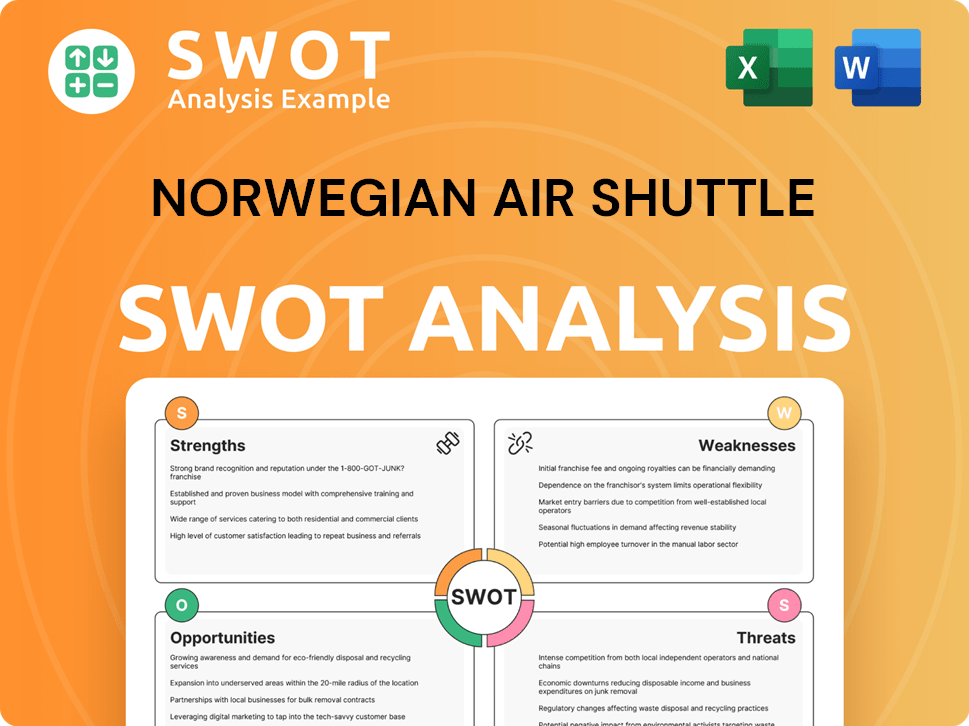
How Does Norwegian Air Shuttle Invest in Innovation?
Norwegian Air Shuttle's innovation and technology strategy focuses on enhancing operational efficiency, improving customer experience, and promoting sustainable growth. The company leverages digital transformation to streamline processes, personalize customer interactions, and optimize pricing. This approach is crucial for navigating the evolving airline industry and meeting the demands of modern travelers.
The airline's commitment to digital solutions is evident in its continuous efforts to enhance online platforms, making travel planning and management more seamless for customers. This includes investments in data analytics to understand passenger behavior and tailor services. The goal is to provide a user-friendly experience that meets the expectations of today's tech-savvy travelers.
Sustainability is a key aspect of Norwegian Air Shuttle's strategy. The company actively pursues initiatives to reduce its environmental footprint, such as investing in more fuel-efficient aircraft and exploring sustainable aviation fuels (SAF). This commitment is part of the airline's broader effort to be a leader in sustainable aviation practices.
Norwegian Air Shuttle has been investing in digital transformation to streamline booking processes and improve its mobile application. This includes the implementation of advanced data analytics to understand passenger behavior and optimize pricing strategies. The focus is on enhancing online platforms for a seamless customer experience.
The airline is committed to reducing its environmental footprint through investments in newer, more fuel-efficient aircraft. They are also exploring sustainable aviation fuels (SAF) to minimize emissions. These efforts align with the growing demand for environmentally responsible travel options.
Norwegian Air Shuttle uses data analytics to understand passenger behavior and optimize various aspects of its operations. This includes pricing strategies, route planning, and customer service improvements. This data-driven approach helps in making informed decisions and enhancing overall efficiency.
The company focuses on personalizing customer interactions and improving the mobile application to enhance the overall travel experience. This includes user-friendly interfaces and features designed to make travel planning and management easier. The goal is to increase customer satisfaction and loyalty.
Investing in newer aircraft is a key element of the sustainability strategy. Modern aircraft are more fuel-efficient, which reduces emissions and lowers operating costs. This also contributes to a better passenger experience with updated amenities and features.
By leveraging technology and data analytics, Norwegian Air Shuttle aims to improve its operational efficiency. This includes optimizing flight operations, maintenance schedules, and resource allocation. The focus is on reducing costs and improving overall performance.
The airline's innovation strategy is geared towards achieving operational excellence and meeting evolving customer expectations. In the post-pandemic travel landscape, efficiency and environmental responsibility are increasingly important. For example, in 2024, the global aviation industry saw a renewed focus on sustainable aviation fuel (SAF) with production and usage growing significantly, though still representing a small percentage of overall fuel consumption. Furthermore, Marketing Strategy of Norwegian Air Shuttle highlights how the company adapts its strategies to stay competitive.
Norwegian Air Shuttle's approach to innovation and technology is multifaceted, focusing on operational improvements, customer experience, and sustainability. The airline's strategic investments in digital platforms and data analytics are designed to drive efficiency and enhance customer satisfaction.
- Digital Platforms: Continuous enhancement of online booking systems and mobile applications to streamline travel planning and management.
- Data Analytics: Implementation of advanced data analytics to understand passenger behavior, optimize pricing, and improve operational efficiency.
- Sustainability Initiatives: Investments in fuel-efficient aircraft and exploration of sustainable aviation fuels (SAF) to reduce environmental impact.
- Operational Efficiency: Leveraging technology to optimize flight operations, maintenance schedules, and resource allocation.
- Customer Experience: Personalizing customer interactions and improving services to meet evolving expectations in the post-pandemic travel landscape.
Norwegian Air Shuttle PESTLE Analysis
- Covers All 6 PESTLE Categories
- No Research Needed – Save Hours of Work
- Built by Experts, Trusted by Consultants
- Instant Download, Ready to Use
- 100% Editable, Fully Customizable
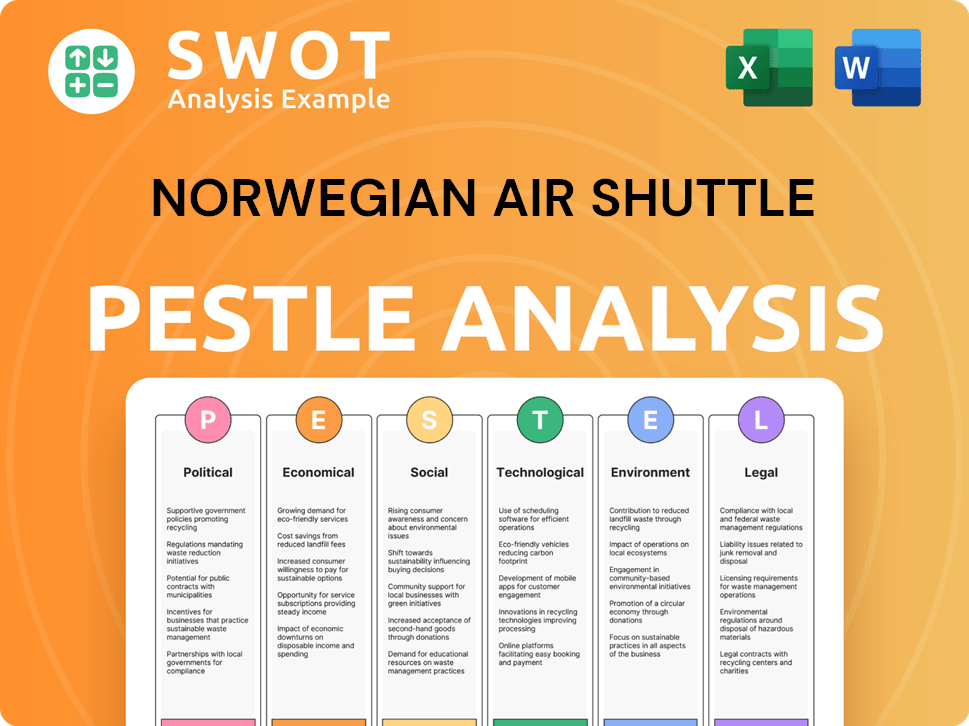
What Is Norwegian Air Shuttle’s Growth Forecast?
The financial outlook for Norwegian Air Shuttle is positive, with the company demonstrating a strong recovery and projecting continued growth. In the first quarter of 2024, the airline reported a profit before tax of NOK 1.2 billion, a significant improvement compared to the previous year. This positive financial performance indicates a solid start to the year, driven by increased demand and efficient cost management.
Revenue for Q1 2024 reached NOK 5.4 billion, up from NOK 4.3 billion in Q1 2023, reflecting increased capacity and passenger numbers. The airline anticipates a positive financial trajectory, supported by robust summer bookings and effective cost control measures. The company's strategic focus is on maintaining a strong financial position and achieving profitable growth, which is key to its future prospects.
The airline expects to transport approximately 23 million passengers in 2024, with a planned capacity increase of around 12% compared to 2023. This growth is supported by a solid cash position, reported at NOK 9.5 billion at the end of Q1 2024. Analyst forecasts generally align with this positive outlook, citing strong operational performance and effective cost control as key drivers of success in the competitive airline industry.
The company's financial strategy centers on maintaining a strong liquidity position and achieving profitable growth. This approach is crucial for delivering sustainable returns to shareholders. The focus on profitability and disciplined capacity management underpins the company's strategic plans.
Revenue for Q1 2024 reached NOK 5.4 billion, a significant increase from NOK 4.3 billion in Q1 2023. This increase reflects the airline's ability to capitalize on increased demand and optimize its route network analysis.
Norwegian anticipates transporting approximately 23 million passengers in 2024. This projection highlights the airline's continued growth and its ability to attract customers in a competitive market.
The airline plans a capacity increase of around 12% compared to 2023. This expansion strategy is a key component of its growth strategy and reflects confidence in its future prospects and expansion plans.
The company reported a solid cash position of NOK 9.5 billion at the end of Q1 2024. This strong financial position provides a buffer for future investments and helps manage the impact of fuel prices on Norwegian Air Shuttle.
The company's long-term financial goals include consistently delivering positive earnings and strengthening its balance sheet. This is supported by a modern and fuel-efficient fleet, contributing to its sustainability initiatives.
Norwegian Air Shuttle Business Model Canvas
- Complete 9-Block Business Model Canvas
- Effortlessly Communicate Your Business Strategy
- Investor-Ready BMC Format
- 100% Editable and Customizable
- Clear and Structured Layout
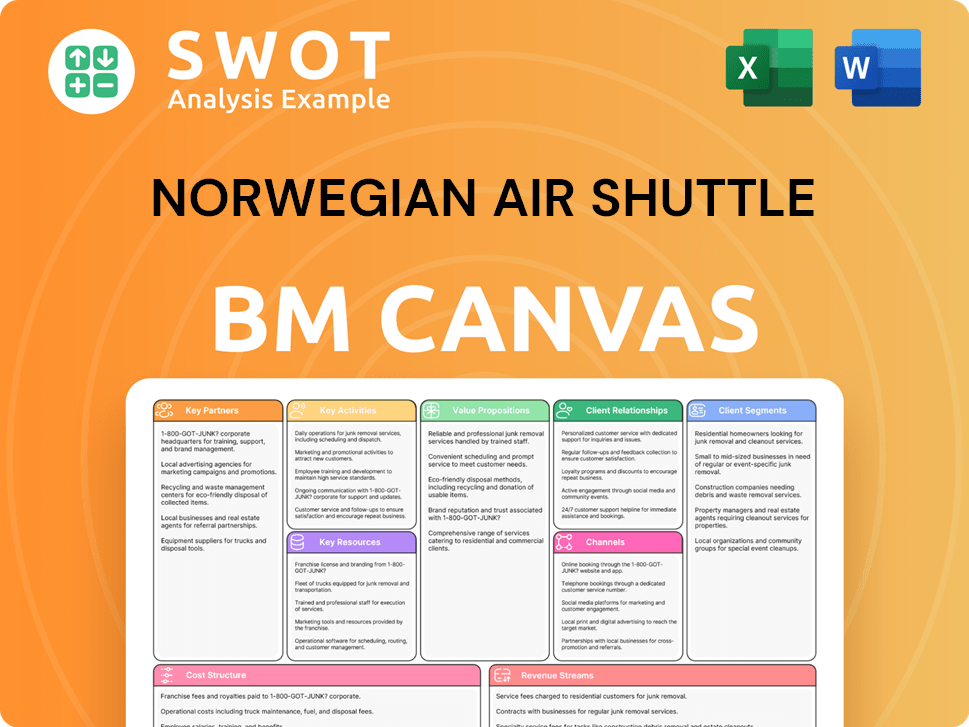
What Risks Could Slow Norwegian Air Shuttle’s Growth?
The Norwegian Air Shuttle faces a complex array of potential risks and obstacles that could influence its growth strategy and future prospects. The airline industry is inherently volatile, and the company must navigate these challenges to achieve its expansion plans. Understanding these risks is crucial for assessing the company's long-term viability and investment potential.
Market competition, regulatory changes, and operational constraints pose significant hurdles. The company's ability to adapt to technological advancements and manage internal resources will be critical. Moreover, external factors such as geopolitical instability and fluctuating fuel prices add further layers of complexity, requiring proactive risk management strategies.
The competitive landscape, particularly in the European low-cost sector, is intense. Several airlines compete for market share, which can lead to price wars and reduced profitability. The company's success depends on its ability to differentiate itself and maintain a competitive edge. The company's route network analysis is crucial to its success.
The European low-cost airline market is highly competitive, with numerous players vying for market share. This competitive pressure can lead to pricing wars and reduced profit margins. The company needs to continually innovate and offer competitive fares to attract and retain passengers.
Changing regulations, especially regarding environmental standards and air traffic control, can increase operational costs. Compliance with these regulations and adapting to new technologies, such as sustainable aviation fuels, are essential for long-term sustainability. The impact of fuel prices on Norwegian Air Shuttle is significant.
Disruptions in the supply chain, particularly concerning aircraft spare parts and maintenance, can cause flight delays and cancellations. Ensuring a reliable supply chain is crucial for maintaining operational efficiency and customer satisfaction. The company's fleet expansion strategy is directly affected.
Rapid advancements in sustainable aviation, digital customer service, and other technologies require the company to adapt quickly. Failure to embrace these changes could lead to a loss of competitiveness. The company's long-term goals depend on staying ahead of technological trends.
Shortages of pilots and cabin crew can hinder capacity expansion and affect operational efficiency. Addressing these shortages and ensuring adequate staffing levels are critical. The company’s ability to manage its workforce directly impacts its ability to grow.
Geopolitical events and economic fluctuations can impact demand and fuel prices. The company must use hedging strategies and dynamic pricing to mitigate these risks. The Norwegian Air Shuttle business model must be flexible.
The company mitigates risks through a diversified route network and a flexible fleet strategy. This allows it to adapt to changing market conditions and reduce its exposure to specific regions or aircraft types. The company's market share is influenced by these factors.
Robust risk management frameworks are essential for identifying and addressing potential threats. These frameworks include hedging strategies to manage fuel price volatility and proactive measures to address supply chain disruptions. The Norwegian Air Shuttle financial performance depends on these strategies.
Fluctuating fuel prices and geopolitical instability are significant external risks. These factors can impact profitability and operational planning. The company must closely monitor these developments and adjust its strategies accordingly. The Norwegian Air Shuttle challenges and opportunities are influenced by these external forces.
The company's ability to adapt to technological advancements and changing customer preferences is crucial. This includes investing in digital customer service and exploring sustainable aviation initiatives. Understanding the Target Market of Norwegian Air Shuttle is also crucial.
Norwegian Air Shuttle Porter's Five Forces Analysis
- Covers All 5 Competitive Forces in Detail
- Structured for Consultants, Students, and Founders
- 100% Editable in Microsoft Word & Excel
- Instant Digital Download – Use Immediately
- Compatible with Mac & PC – Fully Unlocked
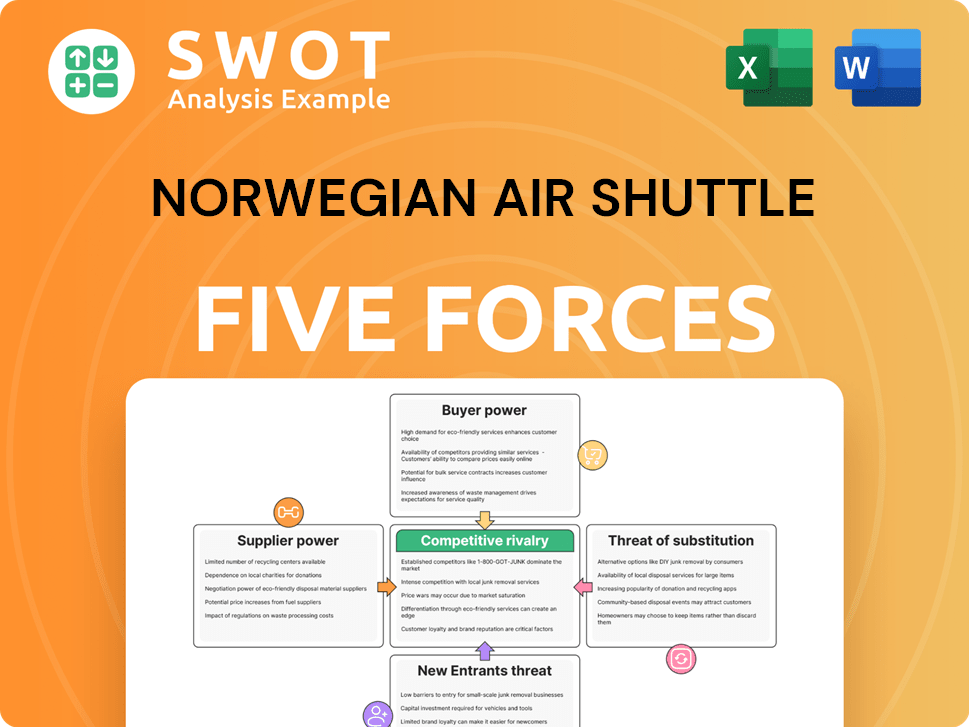
Related Blogs
- What are Mission Vision & Core Values of Norwegian Air Shuttle Company?
- What is Competitive Landscape of Norwegian Air Shuttle Company?
- How Does Norwegian Air Shuttle Company Work?
- What is Sales and Marketing Strategy of Norwegian Air Shuttle Company?
- What is Brief History of Norwegian Air Shuttle Company?
- Who Owns Norwegian Air Shuttle Company?
- What is Customer Demographics and Target Market of Norwegian Air Shuttle Company?
Disclaimer
All information, articles, and product details provided on this website are for general informational and educational purposes only. We do not claim any ownership over, nor do we intend to infringe upon, any trademarks, copyrights, logos, brand names, or other intellectual property mentioned or depicted on this site. Such intellectual property remains the property of its respective owners, and any references here are made solely for identification or informational purposes, without implying any affiliation, endorsement, or partnership.
We make no representations or warranties, express or implied, regarding the accuracy, completeness, or suitability of any content or products presented. Nothing on this website should be construed as legal, tax, investment, financial, medical, or other professional advice. In addition, no part of this site—including articles or product references—constitutes a solicitation, recommendation, endorsement, advertisement, or offer to buy or sell any securities, franchises, or other financial instruments, particularly in jurisdictions where such activity would be unlawful.
All content is of a general nature and may not address the specific circumstances of any individual or entity. It is not a substitute for professional advice or services. Any actions you take based on the information provided here are strictly at your own risk. You accept full responsibility for any decisions or outcomes arising from your use of this website and agree to release us from any liability in connection with your use of, or reliance upon, the content or products found herein.